Homemade Tagliatelle Pasta
There is nothing better than homemade pasta and this Homemade Tagliatelle Pasta has the taste and texture you come to expect with with fresh pasta. It’s not as difficult as you think, I promise.
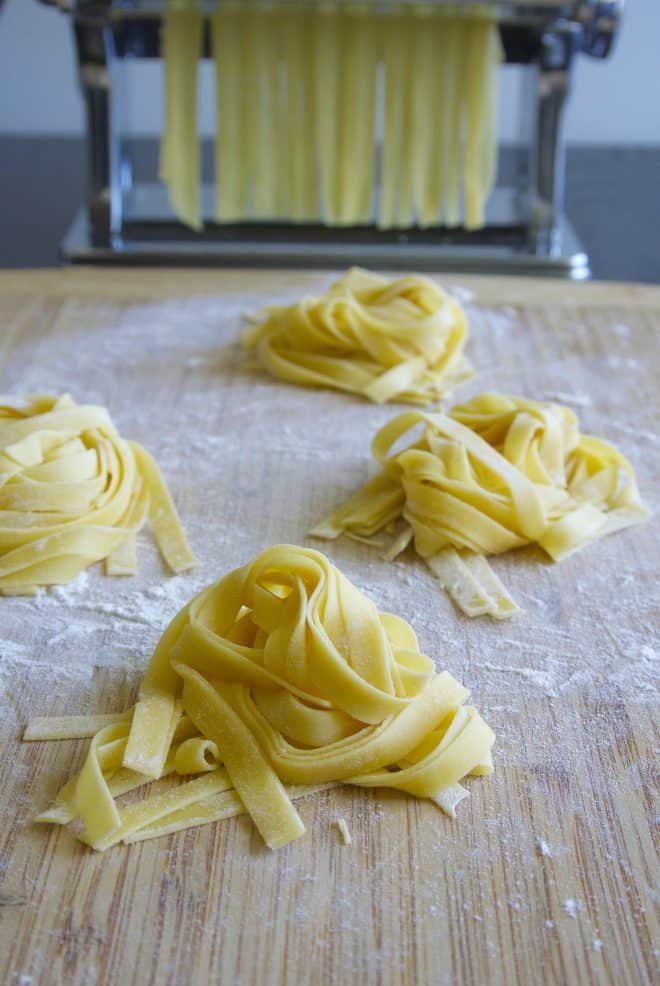
When making homemade pasta, you start with one recipe and you can make any shape pasta you choose, from this tagliatelle to lasagne sheets and spaghetti.
I love fresh pasta and my favorite is tagliatelle from my favorite region of Italy, Emilia Romagna. They are most famous for prosciutto from Parma, balsamic vinegar from Modena and Parmigiano Reggiano (Parmesan), so it is a great place for foodies to visit.

I remember my last visit to Lake Como, my favorite snack was crusty bread, prosciutto and cheese all washed down with Chianti, it is heaven.
Tagliatelle looks very similar to fettuccine, so what’s the difference you ask? Well, traditionally fettuccini are wider noodles traditionally served with creamy sauces, where tagliatelle is thinner and traditionally served with a Tagliatelle Bolognese Sauce.
I find that cooking is an on-going learning process and the more you make a recipe, the more you learn. The last fresh pasta I made was tortellini and where I like the way it turned out, I found that adding olive oil and a little water makes for a softer, more tender dough.
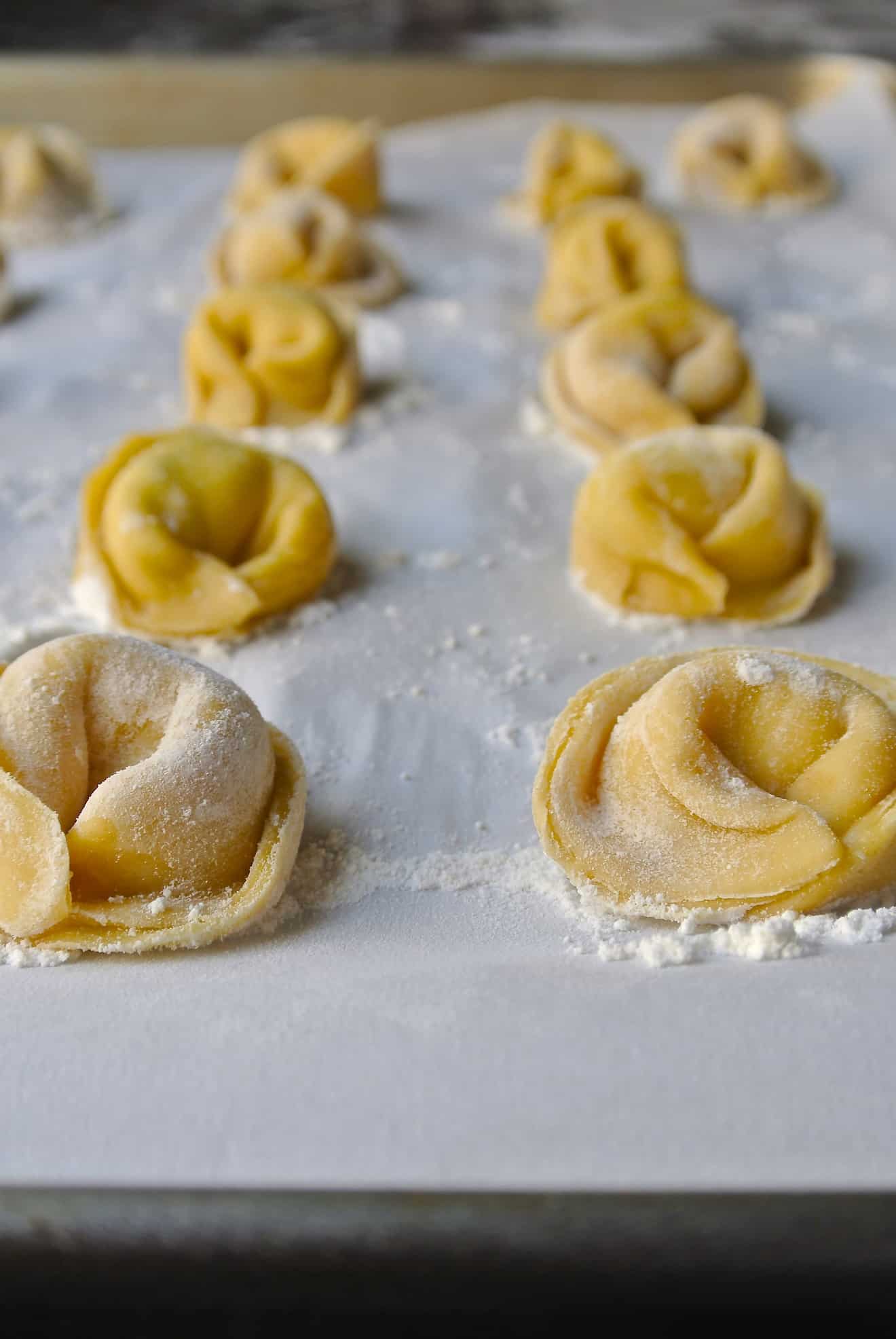
How to Make Homemade Tagliatelle Pasta
The most effective way to make pasta is the old fashioned way. The way they have been doing in Italy for centuries. Just a surface and a fork. You make a well with the flour then add the eggs, salt, olive oil and water, then just mix until the dough comes together.
Don’t use all the flour if you don’t need to, just use only enough for the dough to come together. As you see below, that’s how much flour I was left with.
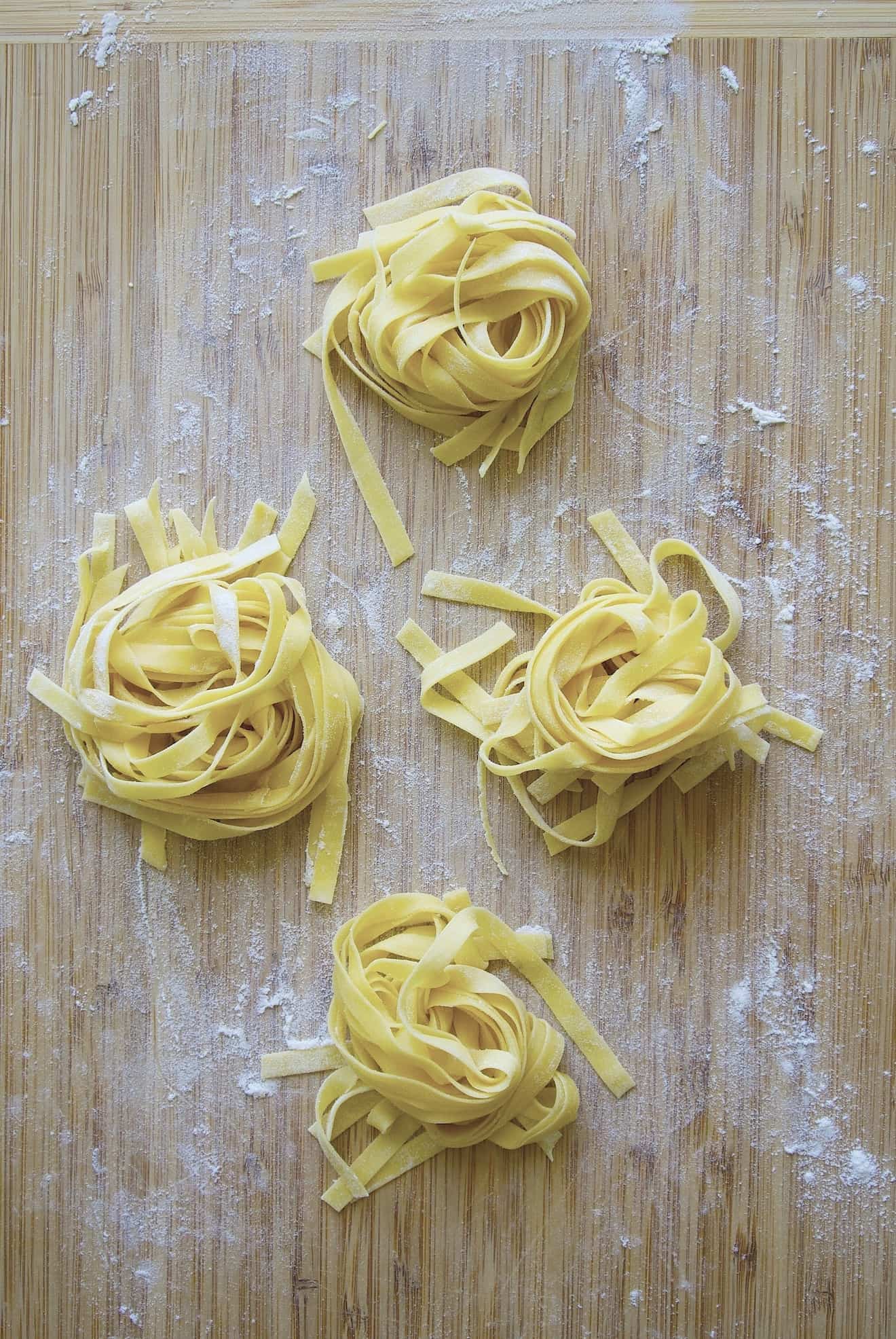
Kneading is key in getting great dough, if you can, knead for about 10 minutes. It’s quite a workout, but you’ll be left with a nice soft dough and as an added bonus your hands will feel soft from the olive oil. Now the dough needs a rest for 30 minutes.
If you’re not familiar with rolling pasta dough, it’s quite simple. Starting with a small rectangle of dough, you run it through your pasta maker at the largest setting, #1.
Once it comes out, dust lightly with flour then fold both ends into the middle. Run it through the machine again on the same setting, then repeat this 2 more times. After the 3rd time, turn the setting to 2, but don’t flour or fold the dough. Turn the setting to 3 and repeat and so on and so on until you reach the thinnest setting. Now your dough is ready to be cut.
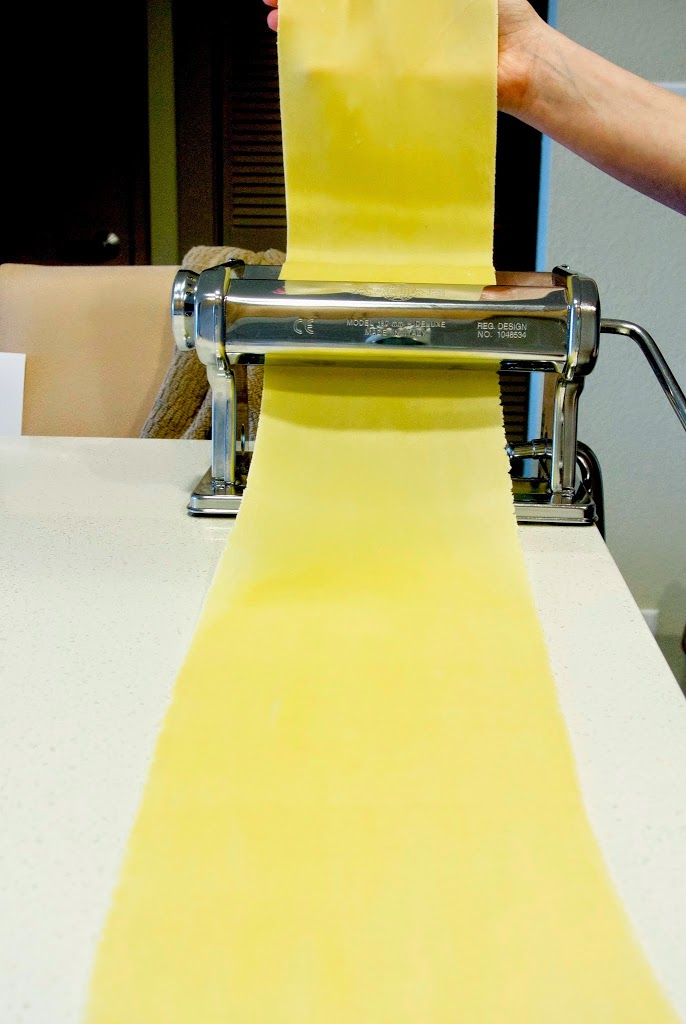
The dough will be long at this point, so lay it on your work surface and cut down to about 12 inches in length. Then run the dough through the thick cutting attachment of your pasta maker. Once the pasta is cut, lay out on a board and dust lightly with flour.
How to make homemade pasta without a pasta maker
- After the dough has rested, take a small amount and roll out as thin as possible using a rolling pin to a rectangle of about 6-inches (15 cm) by 12 inches (30 cm) on a floured surface.
- Take the end closest to you and start to roll, it will be more of a flat roll.
- Using a sharp knife, slice from right to left (or left to right if you’re left-handed) into noodles. This will be the thickness of the pasta strands, so cut at least 3/16-inch (5 mm). The thickness is up to you.
Tagliatelle serving suggestions
Any light sauce is delicious mixed with this fresh pasta. I have a homemade Roasted Fresh Tomato Pasta Sauce or Easy Homemade Marinara Sauce that are perfect for fresh pasta.
On the heavier side, I have sage and cheese sauce or a creamy cheese sauce that I used in baked gnocchi with sage and cheese sauce.
You can even use the pasta to make sheets for Lasagna Bolognese.
The pasta is best used right away. If you want to store it, I like to portion out the pasta, put the in individual freezer bags and freeze for up to 3 months. Then you can just throw the frozen pasta into boiling water when you need it.
This recipe yields 2 pounds/1 kg of pasta
Tagliatelle Pronunciation
Ta-lia-telleh
If you’ve made this Homemade Pasta Tagliatelle or any other recipe leave a comment below. I love to hear from my readers!
Homemade Tagliatelle Pasta

Flour eggs, salt, olive and water are mixed then run through a pasta machine for the perfect homemade pasta.
Ingredients
- 3 cups (390 grams) all-purpose flour
- 4 large eggs room temperature
- 1 teaspoon salt
- 1 tablespoons olive oil
- 2 teaspoons water
Instructions
- On a clean work surface or a bowl, make a mound with the flour. Create a well in the middle and add the eggs, egg yolk, salt, olive oil and water.
- Using a fork, beat the eggs and begin to incorporate the flour from the inner rim of the mound, making sure the mound stays intact with the other hand by cupping the flour.
- The dough will start to come together and once there is no more liquid use your hands to start kneading the dough with the palm of your hands. Do not force the dough to take all the flour, just until the dough comes together and is not too sticky to handle.
- If the dough does take all the flour and is still too sticky, add more flour, a little at a time. Continue to knead for up to 10 minutes, the kneading is what makes the dough nice and light.
- Once the dough is soft and smooth, wrap it in plastic wrap, making sure it is well wrapped so no areas of the dough dries out. Set aside for 30 minutes to rest.
- For pasta machine method:
- Once the dough has rested, cut it into quarters. Take one quarter, wrap the other quarters back in the plastic wrap.
- Shape the quarter with your hands into a rectangle. With your pasta machine set to the largest setting the dough through.
- Fold the dough in half and pass through again on the largest setting. Repeat this 2 more times.
- Turn the machine to the next setting and pass the dough through.
- Keep running the dough through decreasing the setting each time until you reach the last setting.
- Attach the tagliatelle attachment to the machine and pass the dough through one last time.
- Drape the tagliatelle over your hand and transfer to a floured board or baking sheet and allow to dry for 30 minutes. Or if you have a pasta hanger you can use that.
- To make without a pasta maker:
- Take a small amount and roll out as thin as possible using a rolling pin to a rectangle of about 6-inches (15 cm) by 12 inches (30 cm) on a floured surface.
- Take the end closest to you and start to roll, it will be more of a flat roll.
- Using a sharp knife, slice from right to left (or left to right if you're left-handed) into noodles. This will be the thickness of the pasta strands, so cut at least 3/16-inch (5 mm). The thickness is up to you.
Notes
The pasta is best used right away. If you want to store it, I like to portion out the pasta, put the in individual freezer bags and freeze for up to 3 months. Then you can just throw the frozen pasta into boiling water when you need it.
Nutrition Information
Yield
4Serving Size
1Amount Per Serving Calories 279Saturated Fat 1gCholesterol 81mgSodium 420mgCarbohydrates 47gFiber 1gProtein 9g
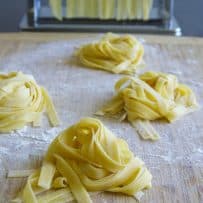
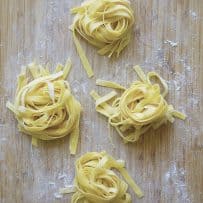
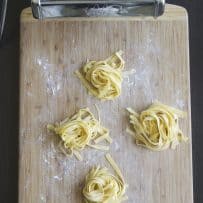
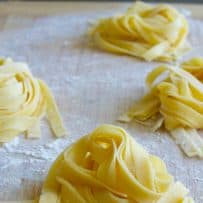

37 Comments on “Homemade Tagliatelle Pasta”
Thank you for the recipe and detailed explanation. I am a saffron producer, therefor my first tagliatelle was with saffron)) It turned delicious, very soft and silky pasta, thanks again.
You’re so welcome 🙂
I just made it for the first time and it turned out great! I made double the recipe and froze the rest.
Fantastic! Thank you for sharing.
OMG!!! After several failed attempts, using other recipes and wasting tons of flour and eggs, I stumbled on this recipe and created the best pasta ever!! Thanks so much…clear instruction …I didn’t change a thing…and holy cow!!
I’m so glad you chose my recipe and it worked for you. Thank you for the feedback.
I am making your Lasagna Bolognese recipe for Christmas. Is a single recipe of your homemade pasta enough for the lasagna or do I need more than one recipe’s worth?
I’m also making my Lasagna for Christmas and making the fresh pasta, so this is a great question. The lasagna requires 1 pound of lasagna sheets and my recipe (I believe) makes more than a pound (based on the amount of flour), so I’m guessing you, and I should be good to go 😂
I used 21/2 cups of all purpose and a half cup of semolina per my chefs instructions. I made this using bread flour also what difference to semolina makes I have no idea but it’s delicious no matter what thank you
Thank you for the tips
Amazing recipe! So easy, but perfect on flavor and texture. Made this twice. The first time I actually added spinach. Thank you so much for sharing!
I love hearing this, thank you. I love that addition of the spinach.
I made this yesterday with my new pasta machine and it turned out so well. I was so proud of my first attempt at homemade pasta, my kids were not impressed so I’m putting it here on the internet 🙂
Ha ha, congratulations! It’s not as daunting as it seems. I’m happy you chose to share the news with us 🙂
Hi. Love, love homemade pasta. I would like to make about a pound and a half of pasta for Easter Sunday. How much additional amounts of ingredients should I add. Thank you in advance.
Joanne
Hi Joanne, this recipe yields about 1 pound of pasta. What I would do is make 2 batches of this recipe because if you double the recipe you’ll find yourself with a giant ball of pasta and this way you’re not having to figure out half measurements. Any leftover pasta will freeze really well, there’s instructions in the recipe. I hope this helps and happy pasta making 🙂
Your pasta looks wonderful, but I am always confused by pictures that show nests of pasta for freezing, but the recipes always say lay out flat or drape pasta On a rack to dry. When it dries it gets hard right, so how do you get it coiled into a nest without it sticking together? Thank you.
Hi Patty, the key is to make sure the pasta is well coated in flour, that way it will not stick to itself. Thanks for stopping by.
So impressive! I love this, I’ve always wanted to venture into homemade pasta. Thank you for sharing and for the beautiful photos!
Thank you! 🙂
You make this look so easy, I have to try
I pinned this – pasta has been on my list for a very long time.
Great, I love making pasta 🙂
Looks delicious! I’ve been meaning to try making homemade pasta.
I never make enough fresh pasta! Yours looks perfect!
Thank you Christina 🙂
Janette, your pasta is absolutely gorgeous! I have never tried making pasta at home before but you make it look so easy 🙂 And I still can’t believe how few ingredients pasta requires. I am waiting for a lazy Saturday to try this out!
I was really excited to see your homemade pasta recipe. My father and I have made pasta together and while there is a little work to it……….nothing beats the flavor. I am holding a Jamie Oliver Food Revolution Day event in May where we will be teaching about 100 Girl Scouts to make their own pasta. It should be a lot of fun. Especially………..when we get to the eating part.
G’day! There is nothing like fresh pasta! Great photos!
Cheers! Joanne
I have never had homemade pasta before. I didn’t realize it was this easy to create. I’ll be trying this over the weekend.
Thank you Nicky 🙂
I love the smell and taste of new pasta!!! I have to admit that I get mesmerized when I see fresh pasta being rolled out. Your pasta and recipe look AMAZING. Do you suggest a red-based or cream-based sauce with this pasta?
Thank you Rini. Traditionally a bolognese is served with tagliatelle, but I’m going to be making it with mushrooms.
I really need to stop being afraid of making pasta, this looks so good. I remember every weekend, as a kid, sitting in my Nana’s house watching her hand crank out pasta all day for everyone. We had pasta hanging everywhere! Thanks, this post brought me back to a lot of good childhood memories and maybe will give me the push to make some.
Christine you really do need to try it, even if it doesn’t work out the first time, it does get easier and it’s so gratifying when you get it right.
Nothing bets home made pasta! Wonderful recipe Janette 🙂 Stunning photography as well!
Thank you Nicole 🙂